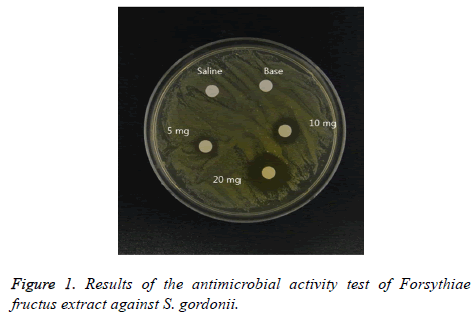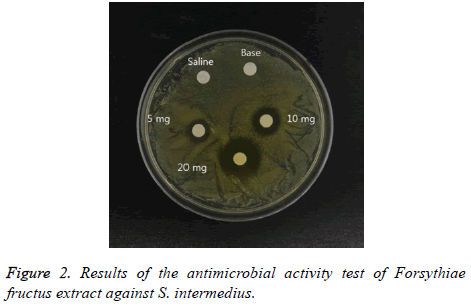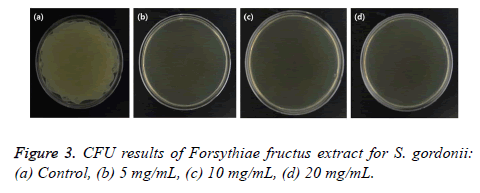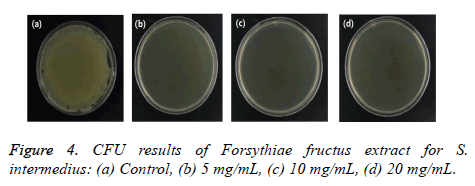ISSN: 0970-938X (Print) | 0976-1683 (Electronic)
Biomedical Research
An International Journal of Medical Sciences
Research Article - Biomedical Research (2019) Volume 30, Issue 3
Antibacterial effect of Forsythiae fructus extract in dental caries.
Jung-ok Choi1, Yu-Ri Choi2 and Seoul-Hee Nam3*
1Department of Dental Hygiene, College of Health Sciences, Youngsan University, Yangsan-Si, Republic of Korea
2Department of Dental Hygiene, Hallym Polytechnic University, Chuncheon-Si, Republic of Korea
3Department of Dental Hygiene, College of Health Sciences, Kangwon National University, Samcheok-Si, Republic of Korea
- *Corresponding Author:
- Seoul-Hee Nam
Department of Dental Hygiene, College of Health Sciences
Kangwon National University
Republic of Korea, Iran
Accepted date: April 29, 2019
DOI: 10.35841/biomedicalresearch.30-19-196
Visit for more related articles at Biomedical ResearchOral-resident bacteria cause various diseases in the oral cavity, and studies have been conducted to inhibit the activities of many of such bacteria. This study was conducted to investigate the antibacterial effect of the natural extract Forsythiae fructus against the oral-resident bacteria Streptococcus intermedius (S. intermedius) and Streptococcus gordonii (S. gordonii), characterized by antiinflammation and antimicrobial activity. The clearzone confirmation method was used to test the antimicrobial activity, and the number of colony-forming units (CFUs) was checked to measure the bacterial proliferation. For the experiment, 5, 10 and 20 mg/mL of Forsythiae fructus extract were set as the experimental groups, and the group without any treatment was set as the control group. For the results of the antimicrobial activity testing, the size of the clear zone became larger as the concentration increased from 5 to 10 and 20 mg/mL compared to the control group. As for the results of the CFU measurement, many bacteria were observed in the control group while no bacteria appeared in all the experimental groups. Therefore, the present study confirmed the antibacterial effect of Forsythiae fructus extract in the oral cavity, which could be used as basic data for the development of antimicrobial agents using natural extracts against oral-resident bacteria.
Keywords
Antibacterial effect, Dental caries, Oral bacteria, Forsythiae fructus, Oral hygiene
Introduction
The oral cavity has an environment suitable for the proliferation of bacteria, thus always having resident bacterial communities where various bacteria settle. It is also a place where invasion of microorganisms occurs through direct contact with the outside [1]. In the oral cavities of ordinary people, more than 30 species of bacteria are usually isolated, and they appear in various forms depending on the age, health level, dietary level, and hygiene level [2].
The pathological mechanisms that can be caused by oral microorganisms include dental caries, periodontal disease, and missing teeth [3]. These bacterial diseases are developed through the following mechanism. The acid is generated in the process where large amounts of Viridans streptococci and lactobacilli break down the sugars remaining in the oral cavity, and the acid produced is attached to the tooth surface, dissolving or demineralizing the inorganic substance, and eventually destroying the dental tissue [4]. Many studies have attempted to classify Viridans streptococci, and they are known as consisting of four groups: Anginosus (S. nginosus, S. constellatus, S. intermedius), Mitis (S. oralis, S. mitis, S. gordonii, S. sanguinis, S. parasanguis), Salivarius (S. vestibularis, S. salivarius), and Mutans (S. mutans, S. sorbinus) [5]. These bacteria have been reported to be present as resident bacteria in the oral cavity, gastrointestinal tract, and female genital organ, and to cause bacteremia and endocarditis through opportunistic infection [6,7].
Forsythiae fructus is a forsythia fruit of the forsythia plant belonging to Oleaceae, and is known to mainly contain lignans, such as phillyrin (forsythin), phillygenin, (+)-pinoresinol, and (+) pinoresinol-β-d-glycosides [8]. The pharmacological actions of Forsythiae fructus have been known as antiinflammation, antipyretic action, liver function protection, and vasodilation. Previous studies have been conducted on the antimicrobial activity, whitening function, suppression of production of inflammatory mediators, and antioxidant-related antiviral agents of Forsythiae fructus extract [9-11] but the studies on its effects against the causative bacteria of dental caries and periodontal diseases have been limited.
Therefore, this study was conducted to investigate the antimicrobial activity of Forsythiae fructus ethanol extract against the causative bacteria of dental caries and periodontal diseases to identify its efficacy and determine its usability for the development of various oral hygiene products for the prevention of oral diseases [12,13].
Materials and Methods
Experiment materials
Forsythiae fructus was purchased from Food synergy Co., Ltd. (Seoul, South Korea). After adding 80% ethanol to 100 g of crushed Coptis Chinensis, the extraction was done at 65°C for 12 hours. The extract was filtered and was concentrated using a rotary vacuum evaporator (N-1300E.V.S EYELA Co., Japan). The concentrated Forsythiae fructus extract was again lyophilized using a freeze dryer (FD5508, Ilshin Lab, Yangjukun, Kyunggi-do, South Korea), and was diluted in distilled water to form 5, 10 and 20 mg/mL concentrations. For the control group, only brain heart infusion (BHI; Sigma- Aldrich, St. Louis, MO, USA) was used.
Experimental bacteria
S. intermedius (ATCC 9895) and S. gordonii (ATCC 10558) were purchased from Korean Culture Center of Microorganisms (KCCM). Each microorganism was activated at the BHI and was diluted at a 1 × 106 ratio.
Experiment Method
Antimicrobial activity test
To test the antimicrobial activity of Forsythiae fructus extract, 100 μL (1 × 106) each of S. intermedius and S. gordonii was applied on a solid medium, respectively, and after the bacteria were absorbed, 100 μL of each experimental group was dropped onto the paper disc carefully placed on the solid medium. After keeping such paper disc in a 37°C bacterial incubator for 24 hours, the diameter of the clear zone was measured. The average value and standard deviation were obtained after three repeated experiments to measure the diameter of the clear zone, where the bacterial activity was inhibited. Only the average value was recorded, however, because the degree of deviation was insignificant.
Measurement of bacterial proliferation
To measure the bacterial proliferation, the media for the bacteria (1 × 105) were mixed at a ratio of 9 (BHI):1 (bacteria). Then the resulting mixture was mixed with the extracts prepared at 5, 10 and 20 mg/mL concentrations, and 100 μL of each mixture was inoculated into the solid medium. After keeping the final mixture in a 37°C bacterial incubator for 24 hours, the number of colony forming units (CFUs) was checked.
Results
Measurement of inhibition zone
For the results of the antimicrobial activity test of Forsythiae fructus extract against S. gordonii, a 15 mm clear zone was observed in the 5 mg/mL group, a 20 mm clear zone in the 10 mg/mL group, and a 30 mm clear zone in the 20 mg/mL group. As for the results of S. intermedius, a 13 mm clear zone was observed in the 5 mg/mL group, an 18 mm clear zone in the 10 mg/mL group, and a 30 mm clear zone in the 20 mg/mL group.
Antimicrobial activity test
The results of the antimicrobial activity test of Forsythiae fructus extract against S. gordonii and S. intermedius showed that many bacteria survived in the control group, which had no treatment, but no bacteria were observed overall in the 5, 10 and 20 mg/mL experimental groups (Figures 1-4).
Discussion
In relation to the antimicrobial activity of a natural product against oral microorganisms, funoran, a substance extracted from algae, has been reported to have an excellent antibacterial effect on dental-caries inducing bacteria [14]. Several natural extracts, such as green tea, propolis, flavonoids, chitosan, Akebia quinata, cinnamon, Ulmus davidiana, and Schisandra chinensis, have been reported to inhibit the development of dental plaque disease [15,16]. In addition, grapefruit seed, cassia seed, and Korean angelica root showed an anti-caries effect [17]. Among the 105 kinds of herbal medicines, Korean Aristolochia fruit, buckler fern, dried clove buds, Hemerocallis fulva, pinellia, Adonis amurensis, and Scrophularia root have been reported to have an excellent growth inhibitory effect against dental-caries-inducing bacteria [18]. There have been few studies, however, on the anti-caries effect of Forsythiae fructus, the natural substance that was used in this study.
With regard to Forsythiae fructus, various physiological activities, such as the anticancer, antimicrobial, and antiviral activities, have been reported [19]. In particular, it has been reported to have antimicrobial activity against Staphylococcus aureus, Dysentery bacillus, Streptococcus hemolytic, Diplococcus pneumoniae, and eruptive typhus, and has also been reported to have a therapeutic effect on tuberculosis because it significantly inhibits the tubercular bacillus [20]. According to the results of the present study, the inhibition zone against S. intermedius measured 13 mm in the 5 mg/mL group, 18 mm in the 10 mg/mL group, and 30 mm in the 20 mg/mL group. The inhibition zone against S. gordonii, on the other hand, measured 15 mm in the 5 mg/mL group, 20 mm in the 10 mg/mL group, and 30 mm in the 20 mg/mL group. As the concentration increased, a more pronounced and larger inhibition zone appeared. For the CFU results of each Forsythiae fructus extract sample, there was an antibacterial effect at 5 mg/mL against S. intermedius and S. gordonii. This result was consistent with the clear-zone results: a definite clear zone was shown at 5 mg/mL, and the same antibacterial effect was also seen in the CFU result.
Therefore, Forsythiae fructus extract showed a remarkable antibacterial effect against the dental-caries inducing bacteria S. intermedius and S. gordonii, suggesting that it could have an anti-caries effect, preventing or alleviating dental caries.
Conclusion
In this study, Forsythiae fructus ethanol extract, which is known to have antimicrobial, antiviral, and anticancer effects, was proven to be effective through the measurement of the clear zone and colony-forming units (CFUs) to confirm its antimicrobial activity against the oral-resident bacteria Streptococcus intermedius (S. intermedius) and Streptococcus gordonii (S. gordonii). Forsythiae fructus extract revealed the largest clear zone when 20 mg/mL of it was applied to the two aforementioned bacteria, and the death rate of the said bacteria was improved according to the concentration. If these study results lead to the development of an oral product that can prevent and treat dental caries, one of the typical oral diseases, it can be used as an alternative to maintain and promote oral health. The development of complex extracts containing Forsythiae fructus rather than single extracts through continuous research will promote the growth of oral hygiene products.
Acknowledgements
This study was supported by the Basic Science Research Program through a National Research Foundation of Korea (NRF) grant funded by the Ministry of Science, ICT, and Future Planning (2017R1C1B5074410).
References
- Yu YE, Park EY, Jung DH. Antibacterial effect of oriental medicinal herbs on dental pathogens. J Microbiol 2010;46:200-206.
- Lee BB, Ha YM, Shin SH, Jo MK. Antimicrobial activity of test dentifrice product containing grapefruit seed extract and processed sulfur solution against oral pathogens. J Life Sci 2009;19:956-962.
- Yoo SY, Kim PS, Hwang HK, Lim SH, Kim KW, Choe SJ, Min BM, Kook JK. Identification of non-mutans streptococci organisms in dental plaques recovering on mitis-salivarius bacitracin agar medium. J Microbiol 2005;43:204-208.
- Jeon EH, Han JH, Ahn TY. Comparison of bacterial composition between human saliva and dental unit water system. J Microbiol 2007;45:1-5.
- Jeong HJ, Kim SJ. Distribution and antimicrobial susceptibility of bacteria in the oral cavity of smokers or non-Smokers. J Microbiol 2010; 46:334-340.
- Cho EH, Lee NY. Clinical significance of viridians Streptococcal bacteremia. Korean J Lab Med 2003; 23:246-250.
- Yoo SY, Kim PS, Hwang HK, Lim SH, Kim KW, Choe SJ, Min BM, Kook JK. Identification of non mutans Streptococci organisms in dental plaques recovering on mitis-salivarius bacitracin agar medium. J Microbiol 2005; 43:204-208.
- Kim ST, Kim JS, Choe YU, Kim YK. The Combined Anti-apoptotic Effect from tamiflu and pinoresinol of Forsythia fructus extract against influenza virus Infection. Kor J Pharmacogn 2011; 42:9-14.
- Lee JN, Park JH, Kim SW. A Study on the Whitening Effect of the Oriental Medicinal Herb Forsythia suspensa fruit as a cosmetic Ingredient. J Spc Cosmet Sci Korea 2007; 33:79-86.
- Bae JH, Son KH, Lee EJ. Synergistic antimicrobial effect of patrinia scabiosaefolia and Forsythiae fructus extracts on food- borne pathogens. Kor J Microbiol Biotechnol. 2005;33:130-135.
- Lee JM, Choi SW, Cho SH. Effect of Forsythia viridissima Extracts on antioxidative system and lipid peroxidation of liver in rats fed high-cholesterol diet. J Nutr Health 2003; 36:990-996.
- Takahashi N. Micro Bialeco system in the oral cavity: Metabolic diversity in an ecological niche and its relationship with oral diseases. Int Congr Ser 2005;1284:103-112.
- Loesche WJ. Role of Streptococcus mutans in human dental decay. Microbiol Rev 1986;50:353-380.
- Saeki Y, Kato T, Naito Y, Takazoe I, Okuda K.. Inhibitory effects of funoran on the adherence and colonization of mutans streptococci. Caries Res 1994; 30:119-125.
- Otake S, Makimura M, Kuroki T, Nishihara Y, Hirasawa M. Anticaries effects of polyphenolic compounds from Japanese green tea. Caries Res 1991; 25:438-443.
- Ikeno K, Ikeno T, Miyazawa C. Effects of propolis on dental caries in rats. Caries Res 1991; 25:347-351.
- Yoo YJ, Kwak WA, Jo JG. Proliferation inhibitory effects of grapefruit seed, cassia seed and Korean angelica root against Streptococcus mutans. J Korean Acad Dent Health 1996; 20:107-120.
- Do DS, Lee, SM, Na MG, Bae K. Antimicrobial activity of medicinal herb extracts against Streptococcus mutans OMZ 176. Korean J Pharmacogn 2002; 33:319-323.
- Bae JH, Kim YH, Jang JY. Antimicrobial effect of Forsythiae Fructus extracts on several food-borne pathogens. Korean J Food Cook Sci 2005; 3:319-325.
- Ni LJ, Zhang LG, Hou J, Shi WZ, Guo ML. A strategy for evaluating antipyretic efficacy of Chinese herbal medicines based on UV spectra fingerprints. J Ethnopharmacol 2009; 124:79-86.



